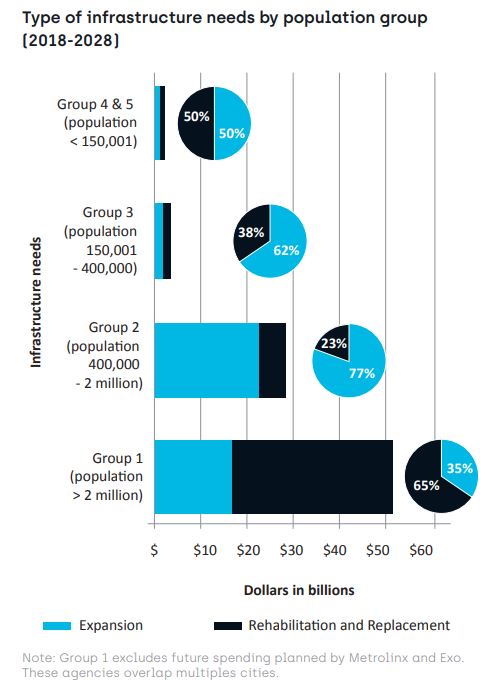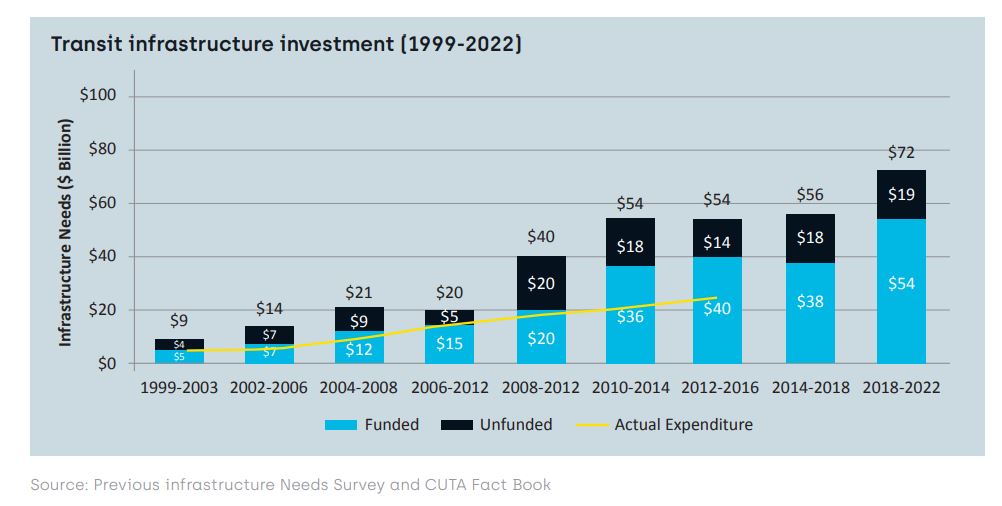Over the past several years, all levels of Canadian government have embraced transit as a way to manage increasing congestion in cities, enhance mobility, ensure economic competitiveness and reduce carbon emissions. As the transit industry works to provide urban mobility solutions, it is important to understand the types of investments that transit systems need and the level of actual investment they receive. Steer has recently worked with the Canadian Urban Transit Association (CUTA) to complete a survey and develop a predictive model to gauge transit infrastructure and funding needs for Canada through 2028.
Several key factors are currently shaping transit infrastructure investment needs, including:
• Population growth
Population growth is a challenge that many transit agencies in large cities address by building capacity and improving service (through technology integration or/and expanding service). Identifying sustainable revenue streams is key to expand service to meet growing transit demand. However, trends in costs and revenues show that current revenue sources are not keeping pace with the growing financial needs.
• Infrastructure deficit
Like many western countries, Canada has a well-documented infrastructure deficit, including in the transportation industry, which has emerged due to decades of underinvestment. In the past two decades P3s have emerged as a prevalent delivery method to reduce the infrastructure gap in Canada. The increased number of P3s and other new approaches to procure transit projects is a trend that is likely to continue as fiscal constraints increase. All governments have shown growing interest in exploring private sector investments, ownership options, and alternative financing mechanisms to increase investment in new and existing infrastructure.
• Climate change
Across transit agencies and government bodies, climate change is a key driver of risk and uncertainty. As Canada experiences more frequent extreme weather conditions, the effectiveness, lifespan, maintenance, rehabilitation and renewal of existing infrastructure will be affected. Canada has responded to these risks and uncertainties by declaring lower emission targets and increased funding to support alternative fuel technology. Consequently, integrating new technology will be costly in the short-term and the unit costs of maintaining and expanding existing transit infrastructure will be more expensive than before.
• New technology
As the demand for a low-carbon market and tightening emissions regulations drive technology changes, the challenge lies in acquiring additional funding to support the high costs associated with introducing technology and the infrastructure required to support it. Increased costs associated with technology changes do not guarantee increased transit in terms of coverage and ridership.
• Customers’ expectations
In addition to environmental considerations and accelerated population growth, changes in consumer expectations are challenging transit agencies to expand and elevate service quality at the same time. In response, transit agencies and government are looking more towards private partnerships and alternative funding procurement and sources to fill the gap in funding and technological innovation.
2018-2028 transit infrastructure needs outlook
In the summer of 2018, CUTA commissioned Steer to develop and conduct a national transit infrastructure needs survey, develop a forecasting model to supplement missing data and assess potential investment scenarios for the next decade. This study allowed us to better understand the transit infrastructure situation in Canada.
Level of investment needed
We estimate Canadian public transit systems need more than $130.6 billion to pursue their planned, unprecedented growth over the next decade. This $130.6 billion includes both infrastructure projects for which funding has already been allocated or committed, as well as projects that are currently unfunded and can only be completed if additional funding sources were made available. Funded projects make up $72.8 billion, or slightly more than half (56%) of the infrastructure needs for the 2018-2028 period.
Canada’s three largest metropolitan centers (Toronto, Montréal and Vancouver) report the greatest infrastructure needs in Canada, totaling more than 61% of the country's needs over the next decade. Future expenditures of the transit agencies in those centers primarily focus on maintaining the quality of existing infrastructure, while regional agencies focus on expanding and integrating transit network and services cross the metropolitan region. Smaller communities appear to focus more on the expansion of their current operations to respond to new demand.


Growth in investment
Transit capital investment requirements in Canada have developed over the past decades as federal, provincial and municipal governments increased their investments in public transit, ensuring that people move freely in a highly competitive economic environment while reducing emissions. The figure above presents the total infrastructure investment needs in five-year increments from 1999 to 2022. Canada’s transit infrastructure investment continues to increase from the 1999-2003 baseline, to the current estimate of $72.2 billion for the period 2018-2022. This is reflective of a national effort to expand transit networks across the country, particularly in larger centers.
The figure also reflects that actual spending, provided by federal, provincial and municipal governments, has fallen behind projected needs (even funded needs) as the level of projects has increased. Transit agencies across the country appear to have accumulated a backlog of infrastructure projects. Delay in construction projects is a common phenomenon and often a costly problem that will need to be tackled in the next decade. Another explanation for this trend could have to do with accounting: the federal government, who began growing its commitment to transit funding around 2006, makes its contribution to a given project only after receipts have been filled by project proponents, delaying actual expenditures.
Conclusion
Efficient and sustainable public transit plays an important role in keeping Canadian communities among the best places to live in the world, while contributing to clean economic growth. To ensure that transit systems continue to meet their overall mobility objectives, as well as transit mode share and emissions targets, federal, provincial and municipal governments, as well as the private sector and citizens, need to collaborate and find new innovative funding solutions to sustain extensive expansion of transit networks across the country while maintaining the state of good repair in current and future assets. This includes finding ways to reduce delays in the procurement and funding processes as well as developing a stronger understanding of the importance of infrastructure funding to economic, environmental and local mobility objectives.
To find out more, contact: myriam.langlois@steergroup.com
The full report is available on the CUTA website: Canadian Transit Infrastructure Needs Report (PDF)